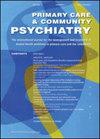Screening for Suicidal Behaviour and Mental Disorders With Prime-MD Questionnaire in General Practice
引用次数: 5
Abstract
Background: The major risk factors for completed suicide are previous suicide attempts and mental disorders. Lifetime prevalence of suicide attempts is 3-4%; and primary care is a major basis for suicide prevention. Aim: To assess the value of a screening method developed to determine the prevalence of suicidal behaviour, and to describe the characteristics of suicide attempters in primary care, including screening for major mental disorders. Methods: A Hungarian urban general practitioner's district with 1248 inhabitants was screened for suicidal behaviour and for major mental disorders. The Prime-MD questionnaire (Primary Care Evaluation of Mental Disorders) was used to recognize the most common psychiatric disorders; suicidal behaviour was assessed by six structured questions of MINI-Plus diagnostic interview. Results: Prevalence of patients with suicide attempts in primary care was 2.9%; 9% of the patients had either suicidal thoughts or gestures the month before. Self-destructive thoughts or behaviour often coexisted with depressive disorders, 60% of suicidal patients and 11.5% of the screened population had depressive episode. According to multivariate logistic regression, suicidal patients were more likely to take antidepressants, they also had a tendency to have more previous psychiatric treatments and suicide attempts; they visited their General Practitioners less frequently and were more likely to have current depressive episodes. Conclusion: The Prime-MD questionnaire, complemented with questions on suicidal behaviour, is an effective, easy-to-use method for general practitioners to assess suicide risk and to recognize the most common mental disorders. This method can be of great help and is proposed for use by general practitioners in every-day practice.在全科医生中使用启动- md问卷筛查自杀行为和精神障碍
背景:自杀未遂的主要危险因素是既往的自杀企图和精神障碍。自杀企图的终生患病率为3-4%;初级保健是预防自杀的主要基础。目的:评估一种用于确定自杀行为流行程度的筛查方法的价值,并描述初级保健中自杀未遂者的特征,包括对主要精神障碍的筛查。方法:对匈牙利城市全科医生区1248名居民进行自杀行为和主要精神障碍筛查。使用Prime-MD问卷(初级保健精神障碍评估)来识别最常见的精神障碍;自杀行为通过MINI-Plus诊断访谈的六个结构化问题进行评估。结果:在初级保健中自杀未遂的患者患病率为2.9%;9%的患者在一个月前有过自杀的想法或行为。自我毁灭的想法或行为通常与抑郁症并存,60%的自杀患者和11.5%的筛查人群有抑郁发作。多因素logistic回归分析结果显示,自杀倾向患者服用抗抑郁药物的可能性较大,且既往精神科治疗和自杀倾向较多;他们去看全科医生的频率更低,而且更有可能出现抑郁发作。结论:Prime-MD问卷与自杀行为问题相结合,是全科医生评估自杀风险和识别最常见精神障碍的有效且易于使用的方法。这种方法可以有很大的帮助,建议全科医生在日常实践中使用。
本文章由计算机程序翻译,如有差异,请以英文原文为准。
求助全文
约1分钟内获得全文
求助全文

 求助内容:
求助内容: 应助结果提醒方式:
应助结果提醒方式:


